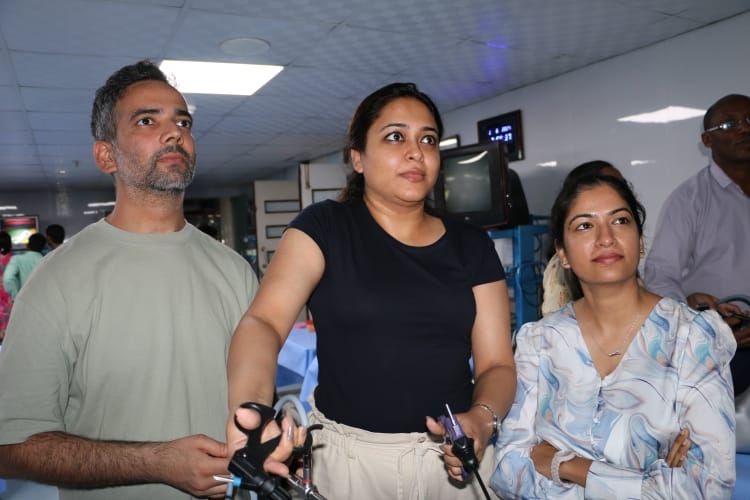Event Date: Thu - 15 Aug, 2024
Event Time: 9:05 am
Location: World Laparoscopy Hospital
Institute: WLH
The laparoscopic extracorporeal Weston knot is a specialized surgical technique that is mostly used in laparoscopic surgeries, especially general and gynecological surgeries. This knotting technique has a number of advantages over conventional suturing methods. It was developed to secure and effectively close tissues within the body.The surgical instruments and a laparoscope, a thin tube with a camera and light source, are inserted into the abdomen using trocars, which are small, hollow tubes. The surgeon manipulates and sutures tissues with specialized instruments once they are inside the abdomen.
The following steps are involved in the laparoscopic extracorporeal Weston knot technique:
1. Suturing: The laparoscopic instruments are manipulated by the surgeon to grasp and manipulate the tissues that need to be sutured together.
2. Formation of Knots: The surgeon brings the suture ends out through one of the trocar ports (extracorporeal) rather than tying the knot inside the body, which can be difficult due to limited space and visibility.
3. Tieing a Knot: The surgeon creates a Weston knot outside the body, a type of sliding knot known for its strong hold and ability to hold tension.
4. Concluding the Deal: The surgeon secures the Weston knot with additional throws, knot pushers, or instruments made for laparoscopic knot tying after tightening it to the desired tension.
Advantages • Control and precision: The laparoscopic technique improves suturing precision by allowing for precise tissue manipulation under magnified vision.
• Less emotional trauma: Laparoscopic procedures typically require fewer incisions than open surgeries, minimizing trauma to the surrounding tissues and speeding up recovery.
• Minimized Danger: Surgeons reduce the likelihood of unintended tissue damage or knot slippage within the body by securing knots extracorporeally.
• Effectiveness: The laparoscopic extracorporeal Weston knot technique has the potential to reduce overall procedure times by speeding up the closure of surgical incisions once it is mastered.
The laparoscopic extracorporeal Weston knot is utilized extensively in a number of surgical specialties, including:
• Obstetrics: especially in procedures like hysterectomy and myomectomy, which removes the uterus and fibroid tissue.
• Surgery in general: used in procedures like repairing hernias and bowel surgeries that involve closing tissue.
World Laparoscopy Hospital: A Hub of Contemporary Learning with Daily 8-Hour Hands-On Laparoscopic Training
In the realm of medical education and training, there are institutions that stand out as pioneers, constantly pushing the boundaries of what is possible. One such institution is the World Laparoscopy Hospital, where a contemporary event unfolds every day, featuring a remarkable 8-hour hands-on laparoscopic training program.
A Daily Revolution in Learning
At the heart of the World Laparoscopy Hospital's mission is the commitment to train the next generation of surgeons and medical professionals in the art and science of Minimal Access Surgery. What makes this institution truly exceptional is its daily 8-hour hands-on laparoscopic training program.
The Laparoscopic Revolution
Laparoscopic surgery, often referred to as minimally invasive surgery, has revolutionized the field of surgery in recent decades. Instead of large incisions, this technique involves making tiny keyhole-like openings through which a camera and surgical instruments are inserted. This results in significantly reduced patient trauma, shorter recovery times, and less post-operative pain.
The Daily Experience at World Laparoscopy Hospital
Every day at World Laparoscopy Hospital is a contemporary event in the world of medical education. Here's a glimpse into what a typical day looks like for those fortunate enough to train at this prestigious institution:
1. Intensive Training: The 8-hour hands-on laparoscopic training is an immersive experience where trainees work side by side with experienced surgeons. This hands-on approach ensures that students gain practical skills and confidence in performing laparoscopic procedures.
2. State-of-the-Art Facilities: The hospital boasts state-of-the-art facilities, equipped with the latest laparoscopic instruments and technology. Trainees have access to the same tools and equipment used in modern surgical practices around the world.
3. Expert Faculty: The training is conducted under the guidance of expert faculty members who are pioneers in the field of Minimal Access Surgery. Their wealth of knowledge and experience provides students with invaluable insights and mentorship.
4. Customized Curriculum: The training program is tailored to the specific needs and experience levels of each student. Whether you are a novice or an experienced surgeon looking to refine your skills, there is a program to suit your requirements.
5. Global Reach: World Laparoscopy Hospital attracts medical professionals from all corners of the world. This diverse group of trainees fosters cross-cultural exchanges and collaborations, enriching the learning experience.
6. Research Opportunities: Beyond the hands-on training, the hospital also serves as a hub for research and innovation in the field of Minimal Access Surgery. Trainees have the opportunity to participate in cutting-edge research projects.
Impact Beyond the Classroom
The impact of the daily 8-hour hands-on laparoscopic training at World Laparoscopy Hospital extends far beyond the classroom. Graduates of this program return to their respective countries armed with advanced skills, contributing to the global dissemination of minimally invasive surgical techniques. Patients around the world benefit from the reduced invasiveness, faster recoveries, and improved outcomes that these skilled professionals bring to their practice.
In conclusion, World Laparoscopy Hospital's commitment to daily 8-hour hands-on laparoscopic training is a testament to its dedication to excellence in medical education. By offering a world-class learning environment and fostering a culture of innovation, this institution is shaping the future of surgery, one trainee at a time. It is not just an institution; it is a beacon of hope for patients and a driving force in advancing the field of surgery.


